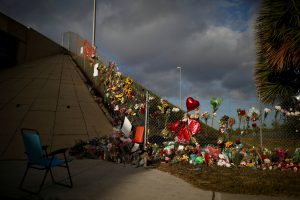
By Rich McKay
(Reuters) – Arm teachers, spend more on school security and mental health and train police to be more aggressive when responding to school shootings — those are some of the recommendations in a report into the deadliest U.S. high school shooting released Wednesday.
The 485-page report into the Parkland, Florida school massacre, that left 14 students and three adults dead at the hands of a lone gunman in February 2018, will be studied by Florida Governor Rick Scott, Governor-elect Ron DeSantis and a state commission charged with finding ways to prevent another school shooting massacre.
The report, by the state-appointed Marjory Stoneman Douglas High School Public Safety Commission, finds a cascade of errors from law enforcement officers holding back as shots were fired and lax school security that allowed a former student with an AR-style semi-automatic rifle access to the campus.

FILE PHOTO: An empty chair is seen in front of flowers and mementoes placed on a fence to commemorate the victims of the mass shooting at Marjory Stoneman Douglas High School, in Parkland, Florida, U.S., February 20, 2018. REUTERS/Carlos Garcia Rawlins
The Parkland shooting has sparked a national debate about school security, gun-rights, and fueled a student-led movement calling for more gun-control, called Never Again MSD, after the school’s initials.
Pinellas County Sheriff Bob Gualtieri, chairman of the school safety commission, told the South Florida Sun Sentinel that there needs to be a sense of urgency in implementing change in school security.
“When you send your kids to school in the morning, there’s an expectation they’re going to come home alive in the afternoon,” Gualtieri told the newspaper.
He also said he strongly supported the idea of arming some gun-trained teachers.
But not everyone on the 16-member commission agreed with all of its findings.
Commission member Lori Alhadeff, whose daughter Alyssa was killed at Stoneman Douglas, told the Sun Sentinel that she opposes the idea of arming teachers.
“Teachers want to teach,” she told the newspaper. “That’s their expertise. Law enforcement, their expertise is supposed to be to engage the threat.”
The report was critical of a perceived slow response from law enforcement officers who waited outside the school buildings while shots were still being fired.
Other recommendations included more funding for mental health services for students, creating safe areas at schools where students can hide from a potential gunman, locking school perimeter gates while school is in session and requiring law enforcement officers to immediately seek out a shooter instead of hanging back.
The report acknowledges that more money is needed to implement the recommendations.
(Reporting by Rich McKay; Editing by Michael Perry)


